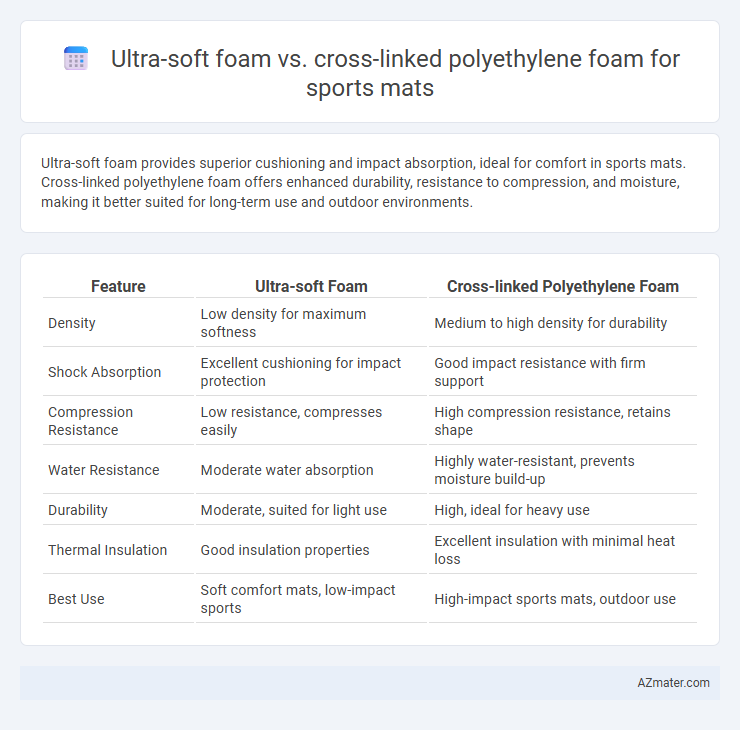Ultra-soft foam provides superior cushioning and impact absorption, ideal for comfort in sports mats. Cross-linked polyethylene foam offers enhanced durability, resistance to compression, and moisture, making it better suited for long-term use and outdoor environments.
Table of Comparison
| Feature | Ultra-soft Foam | Cross-linked Polyethylene Foam |
|---|---|---|
| Density | Low density for maximum softness | Medium to high density for durability |
| Shock Absorption | Excellent cushioning for impact protection | Good impact resistance with firm support |
| Compression Resistance | Low resistance, compresses easily | High compression resistance, retains shape |
| Water Resistance | Moderate water absorption | Highly water-resistant, prevents moisture build-up |
| Durability | Moderate, suited for light use | High, ideal for heavy use |
| Thermal Insulation | Good insulation properties | Excellent insulation with minimal heat loss |
| Best Use | Soft comfort mats, low-impact sports | High-impact sports mats, outdoor use |
Introduction to Sports Mat Materials
Ultra-soft foam and cross-linked polyethylene foam are two popular materials used in sports mats, each offering distinct benefits for athletic performance and safety. Ultra-soft foam provides superior cushioning and shock absorption, making it ideal for activities with high impact or risk of falls. Cross-linked polyethylene foam excels in durability, water resistance, and structural support, making it suitable for long-lasting, versatile sports mats used in gyms and outdoor environments.
Overview of Ultra-soft Foam
Ultra-soft foam, commonly used in sports mats, provides exceptional cushioning and impact absorption to protect athletes during high-intensity activities. Its lightweight and flexible structure offers superior comfort and reduces injury risk by conforming closely to body movements. Compared to cross-linked polyethylene foam, ultra-soft foam prioritizes softness and elasticity, making it ideal for activities requiring enhanced shock absorption and joint support.
Overview of Cross-linked Polyethylene (XLPE) Foam
Cross-linked polyethylene (XLPE) foam is a durable, closed-cell material known for its high resilience and excellent shock absorption, making it ideal for sports mats. Its cross-linked molecular structure enhances tensile strength and resistance to compression, providing superior support during high-impact activities. XLPE foam is also moisture-resistant and easy to clean, ensuring long-lasting performance in athletic environments.
Cushioning and Shock Absorption Comparison
Ultra-soft foam offers superior cushioning with a plush, compressible texture that absorbs impacts gently, making it ideal for low-impact sports activities and comfort-focused mats. Cross-linked polyethylene foam provides enhanced shock absorption and resilient support due to its closed-cell structure, which distributes force effectively and maintains shape under heavy stress, suited for high-impact sports. The choice between ultra-soft foam and cross-linked polyethylene foam depends on the balance needed between softness and durability in sports mat applications.
Durability and Longevity
Cross-linked polyethylene foam offers superior durability for sports mats due to its closed-cell structure, which resists moisture, compression, and wear over time. Ultra-soft foam provides comfort and shock absorption but tends to degrade faster under heavy use and repeated impact. For long-term use in sports environments, cross-linked polyethylene foam maximizes longevity while maintaining consistent performance.
Safety and Injury Prevention
Ultra-soft foam sports mats provide excellent impact absorption, reducing the risk of bruises and joint injuries during falls or intense physical activities. Cross-linked polyethylene foam offers superior durability and consistent shock absorption, enhancing protection against concussions and severe trauma by maintaining cushioning properties over time. Safety standards prioritize energy return and compression resistance, making cross-linked polyethylene foam a preferred choice for high-risk sports environments where injury prevention is critical.
Maintenance and Cleaning
Ultra-soft foam sports mats require gentle cleaning methods to avoid damage, often needing mild detergents and air drying to maintain their cushioning properties. Cross-linked polyethylene foam mats offer superior durability and resist water absorption, allowing for easier cleaning with common disinfectants and quick drying times. Their closed-cell structure reduces bacteria buildup, making maintenance more straightforward and hygienic for sports environments.
Cost and Affordability
Cross-linked polyethylene foam generally offers greater durability and shock absorption at a higher cost, making it a premium choice for sports mats requiring long-term performance. Ultra-soft foam is more affordable and provides excellent cushioning for light to moderate use, appealing to budget-conscious customers seeking immediate comfort. Cost-effectiveness depends on the balance between upfront investment in cross-linked foam and the potential replacement frequency associated with ultra-soft foam mats.
Environmental Impact
Ultra-soft foam for sports mats typically contains polyurethane, which can release volatile organic compounds (VOCs) during production and disposal, contributing to environmental pollution. Cross-linked polyethylene foam is more environmentally friendly due to its recyclability and lower emissions, with a closed-cell structure that resists moisture and microbial growth, reducing waste concerns. Both materials offer durability, but cross-linked polyethylene foam has a significantly reduced ecological footprint through better recyclability and fewer harmful byproducts.
Choosing the Right Sports Mat for Your Needs
Ultra-soft foam sports mats offer exceptional comfort and cushioning, ideal for activities requiring impact absorption like gymnastics and yoga. Cross-linked polyethylene foam mats provide superior durability, water resistance, and firmness, making them suitable for high-traffic areas and intense workouts such as martial arts and weightlifting. Selecting the right sports mat depends on balancing comfort needs with durability requirements based on the specific physical activity and usage frequency.

Infographic: Ultra-soft foam vs Cross-linked polyethylene foam for Sports mat
 azmater.com
azmater.com